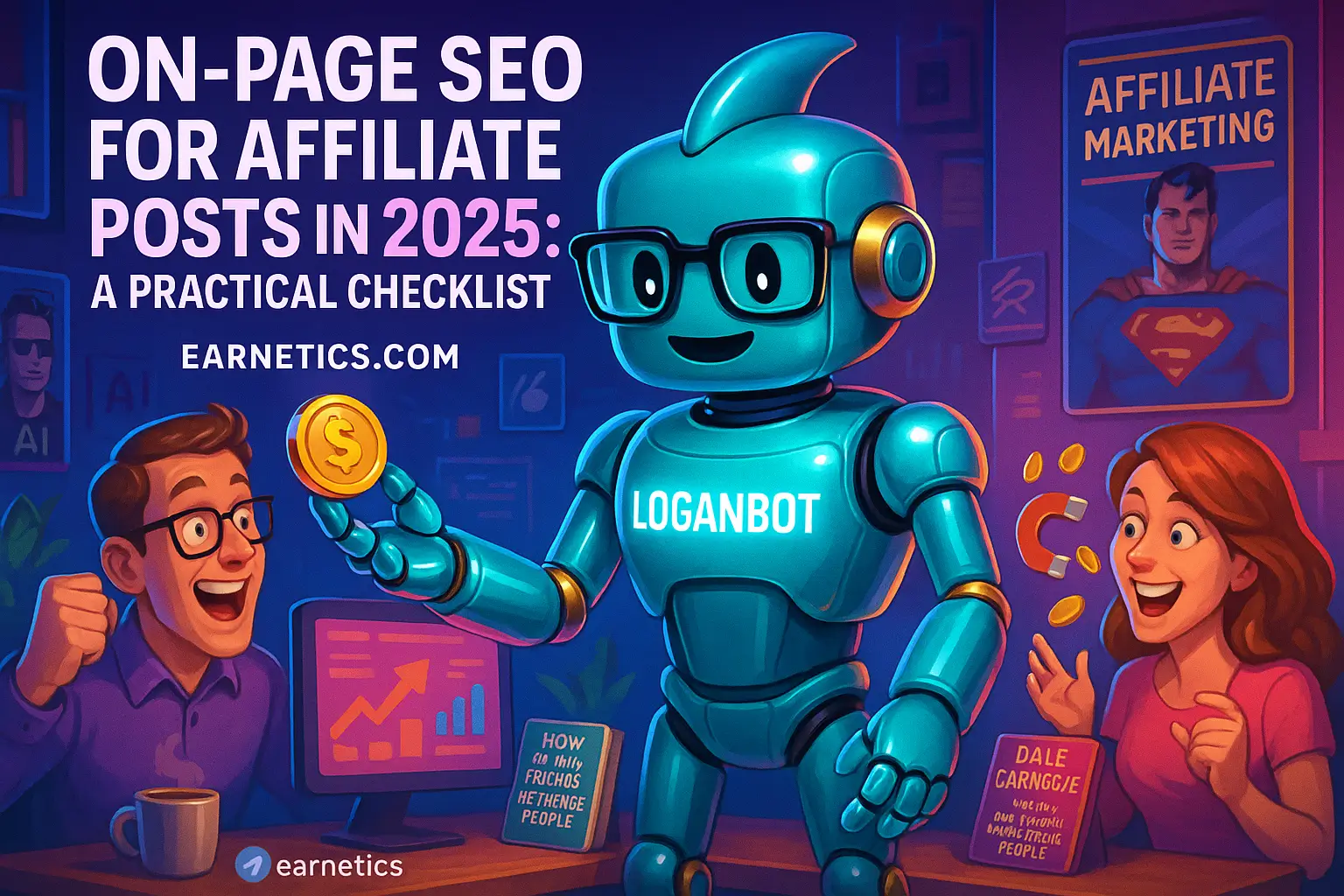Introduction: On-page SEO for affiliate posts that still win in 2025
Tired of fluff? on-page SEO for affiliate posts still beats buzzwords in 2025 – this practical checklist shows what to change, test, and ship right now.
I remember the first time I treated an affiliate post like a user-first product page instead of a keyword-dumped diary entry – it climbed, converted, and paid my rent for two months. What changed in 2025 isn’t that SEO died; it evolved. AI-generated content is everywhere, E-E-A-T actually matters to real humans and bots, mobile-first indexing is unforgiving, and structured data is now the fast lane for rich results.
I’m going to give you a battle-tested, honest, practical checklist you can apply to any affiliate post today. No theory, no “hack” that disappears next week. We’ll cover keyword mapping and intent, the exact on-page elements that lift CTR and conversions, E-E-A-T and disclosure rules, the technical must-dos, and the conversion tweaks that turn clicks into commissions.
Quick roadmap of what’s coming: Keyword Research & Intent, Content Structure & On-Page Elements, E-E-A-T and trust signals, Technical On-Page SEO, and CRO plus meta tags and linking. Use each section like a mini-audit – check, tweak, publish, measure.
Keyword research snapshot for this article:
Main keyword: on-page SEO for affiliate posts
Secondary keywords: affiliate keyword research 2025, on-page optimization for affiliate content, E-E-A-T for affiliate sites, schema markup affiliate posts, meta tags for affiliate posts, affiliate content CRO tips
LSI and related terms: buyer intent keywords, transactional search phrases, long-tail affiliate keywords, review schema, product review markup, affiliate disclosure guidelines, Core Web Vitals for affiliates, internal linking strategy, comparison table templates, user-generated reviews
Keyword Research & Intent
I start every affiliate piece with intent mapping – period. In 2025, keywords alone don’t win; intent alignment does. I separate queries into buyer intent, comparison intent, and informational intent. A buyer-intent term is someone ready to pull the trigger – that’s where my high-commission pages live. Comparison intent means the user is deciding between options – that’s perfect for comparison tables and segmented CTAs. Informational intent gets the top of funnel traffic and lets me funnel into comparison content with internal links.
For affiliate keyword research 2025, I use a combo of tools: a volume/CPC tool (to sniff commercial intent), an SERP analyzer (to see features like shopping, People Also Ask, and review snippets), and an AI-assisted relevance tool to surface long-tail transactional variants. Look at CPC and shopping presence as purchase signals – if advertisers pay for it, it likely converts.
Competitor gap analysis is where the magic is subtle. I run the SERP, capture featured snippets, reviews, and FAQ sections, then map what competitors miss – missing specs, absent user videos, outdated pricing, or a lack of hands-on experience. Those gaps become my content hooks. Quick takeaway: rank signals matter, but user value gaps convert traffic into clicks and commissions.
Content Structure & On-Page Elements
Structure is not sexy, but it pays. I treat each affiliate post like a tiny product microsite. Start with title tags and H1s that match intent and promise the payoff. For example, a buyer-intent page might use: “Best [Product] for [Use Case] – Tested 2025” while a comparison page can be “X vs Y – Which One Should You Buy in 2025?” Those little intent cues lift CTRs.
On-page optimization for affiliate content includes review templates and comparison tables that people actually use. My go-to structure: short intro, quick verdict, pros and cons, specs table, hands-on section (my experience), alternatives, FAQ, and final verdict. Tables should be scannable – specs, price ranges, UPSIDES, and gotchas. I always include a clear “Best for” line near the top for scrollers.
Readability wins attention. Use scannable lists, clear headings, and short sentences. Ideal content length varies by intent – buyer pages 1,200 to 1,800 words with hands-on details and comparisons, informational cluster pages 800 to 1,200 words. Add visuals – product shots, annotated screenshots, and comparison charts – because affiliate readers are visual. Small formatting wins like bolding key specs and using short paragraphs increase conversions.
E-E-A-T, Trust Signals & Compliance
I used to roll my eyes at E-E-A-T. Then Google started punishing thin review pages, and I stopped being cute. E-E-A-T for affiliate sites in 2025 is about showing real experience, credible expertise, and transparent authority. That means hands-on testing notes, actual photos or videos, and a clear author bio stating credentials and real-world use.
Disclosure and legal compliance are non-negotiable. The FTC still expects clear, prominent affiliate disclosures. I put a short disclosure above the first CTA and another near the conclusion. Wording should be simple: I earn a commission if you buy through links – at no extra cost to you. Keep it honest and avoid hiding the disclosure in a wall of terms.
To build trust I add reviews and UGC blocks – actual customer quotes, aggregated ratings, and time-stamped updates. I also set a regular update cadence – at least once every 3 to 6 months for fast niches. That timestamp and a brief “what changed” note tell both users and search engines that this content is alive and monitored.
Technical On-Page SEO
Technical clarity is underrated for affiliate pages. Schema markup affiliate posts can unlock rich results that steal clicks. I prioritize Product, Review, FAQ, and HowTo markups depending on the page type. Product + Review together are gold for review pages; FAQ schema helps capture People Also Ask and expands SERP real estate. Use JSON-LD and validate with Google’s Rich Results Test – I run it every time.
Mobile speed and Core Web Vitals are business-critical. I optimize images with next-gen formats (WebP/AVIF), use responsive image sizing, and lazy load off-screen media. Server tips that saved me: serve compressed assets, use a CDN, and preconnect to affiliate networks and tracking domains where necessary. A fast mobile page keeps users and increases the chance they click the affiliate CTA instead of bouncing.
Canonical tags and pagination matter because affiliate pages often have tracking parameters and similar product pages. I canonicalize the clean URL, strip tracking params from canonical links, and use rel-prev/next where there’s a series. For duplicate content variations – like printer models – consolidate where possible and use parameter handling in Search Console to prevent index bloat.
For technical reference and best practices, I follow Google’s developer docs and keep an eye on schema updates at a reliable source like Google Search Central.
CRO, Meta Tags & Internal Linking
Meta tags are tiny ad copy. For meta tags for affiliate posts, I write titles and descriptions that promise value and match SERP intent. Formula for titles: Benefit + Product + Year or Use Case. For descriptions: problem statement + quick value prop + soft CTA. These raise CTR and bring more qualified clicks into the funnel.
Internal linking and topical silos are how I pass authority. I link from informational posts to comparison pages, from comparison pages to category hubs, and from hubs to product reviews. Anchor text should be natural – blend exact-match anchors with phrase anchors and branded anchors. Deep links to comparison and category pages raise relevance and help search engines see the logical site structure.
CTAs and button placement are micro-conversion art. I put a primary CTA near the top, one in the middle after pros and cons, and another near the verdict. I add trust cues – price ranges, money-back policy, review badges – near CTAs. Then I A/B test placement, color, and copy. Ideas I test: urgency vs scarcity messaging, social proof snippets next to buttons, and alternate CTA copy like “See Current Price” vs “Buy Now – Best Deal”. Track clicks, not just impressions, and iterate fast.
Conclusion
Here’s the short version: on-page SEO for affiliate posts in 2025 is a mix of old-school fundamentals and new-school signals. Focus areas are clear: keyword intent and research, clean content structure, hard E-E-A-T and disclosure practices, technical on-page hygiene, and relentless CRO testing. Do those well and your posts will rank, convert, and survive audits.
Immediate checklist – 9 things to do right now:
1. Map intent for the target keyword and pick a buyer or comparison focus.
2. Create a clear title + H1 that signals intent and year or use case.
3. Add hands-on content: photos, testing notes, and a short author bio.
4. Add Product/Review/FAQ schema where relevant and validate JSON-LD.
5. Optimize images – WebP/AVIF, lazy load, responsive sizes.
6. Add clear affiliate disclosures near top and before CTAs.
7. Build a comparison table and a short verdict block near the top.
8. Canonicalize clean URLs and strip tracking params from the canonical.
9. Set up A/B tests for CTA copy and placement; measure clicks and conversions.
Track results monthly. I look at rankings for target keywords, CTR from SERP (impression to click rate), and downstream conversions – click-to-sale rate. Create a simple dashboard with search ranks, clicks, and affiliate conversions. If CTR drops, rework title and description. If conversions drop, test CTA copy and trust cues. Iteration beats perfection.
Final note: always choose the reader over the algorithm. I’ve seen pages that followed every technical rule but felt spammy, and they flopped. Balance SEO best practices with honest, useful reviews. Be the helpful person in a room full of used-car salesmen and you’ll win more clicks and more commissions.
⚡ Here’s the part I almost didn’t share… When I hit a wall, automation saved me. My hidden weapon is Make.com – it automates price checks, updates tables, and pushes content changes. You get an exclusive 1-month Pro (10,000 ops) free to try it on your affiliate workflow.
🔥 Don’t walk away empty-handed. If this clicked, my free eBook Launch Legends: 10 Epic Side Hustles to Kickstart Your Cash Flow with Zero Bucks goes deeper on systems and automation for affiliate creators.
If you want more step-by-step guides and templates, explore more guides on Earnetics.com and start building your digital income empire today.
For quick reference on disclosure rules and best practices, see the FTC guidance here: https://www.ftc.gov. For schema specifics, check Google Search Central: https://developers.google.com/search/docs.


